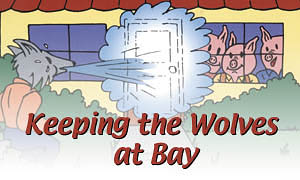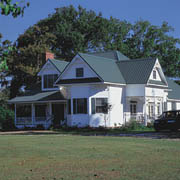Keeping the Wolves at Bay

There’s a new (yet strangely familiar) character in town and he’s coming to your neighborhood next. If you’ve got a metal roof though, B.B. Wolf can huff and puff all he wants, but he can’t hurt you.
Or so goes a recent advertising campaign from the Metal Roofing Alliance, Belfair, Wash. Commercials featuring the doomed exploits of B.B. Wolf and three little pigs (who tried asphalt shingles, cedar shakes and metal shingles when building their houses) ran from April to June 2001. The 30-second spots were seen on HGTV, the Discovery Channel, the Learning Channel and the Weather Channel in the United States and Canada. Separate spots, dubbed in French, were run in Quebec.
“We’re very happy with the B.B. Wolf results,” says Tom Black, president of the MRA. “We were able to run a lot of spots and got a very good response rate. We are now going to turn B.B. Wolf into a broad-based campaign.” The spots direct the consumer to the organization’s Web site, www.metalroofing.com, which was revamped as of April 2001.
One of the popular features on the new site is the “Ask the Experts” section. Consumers and contractors can post questions, bulletin-board style, and experts from the organization’s manufacturing members answer. “We are trying to get more of the members involved,” says Black.
Another big undertaking on the Web site is a sweepstakes where consumers can win a metal roof – up to 30 squares. So far, there have been 30,000 respondents. The names are forwarded to contractors and manufacturers. A total of six roofs will be given away. All were donated by manufactures: two from Accel (Atas’ residential line) and one each from Classic Products, Dura-Loc, Owens Corning Mira Vista, and Tasman Roofing (Decra). Four roofs have been given away as of press time, the last two to be awarded on September 1 and November 15. People sign up once and are entered in each drawing. Black suspects that the MRA will do some sort of variation of the sweepstakes next year, perhaps with one or two drawings.
The Big News
The most exciting news from the MRA is a new contractor program. “Up until now, all of the consumer leads and requests from our Web site have been given to the manufacturers who then pass them along to the contractors,” explains Black. “But we realized that when consumers go to the site, they want an instant response. They want information, and/or they want to find a contractor. So, we are now going to match consumers and contractors directly on the Web site. When consumers type in their zip codes, a list of local contractors and their service areas will pop up.”The MRA’s member manufacturers will sponsor contractors into the organization as members free of charge for the first year. A membership fee will then be instituted some time in mid 2002. Black is not sure at this point how much that fee will be, but he expects that it will be under $500. “Our objective is to have a large group of contractors that cover the country. The membership will be free for the first year because we want contractors to see the benefit of being matched up with consumers. Hopefully by next July, they will have had several match-ups.”
Contractors will also have access to the B.B. Wolf material, including TV and radio spots to tag. “We are also developing other ways to generate attention, like yard signs and print material. But TV is still the most effective way to reach the consumer.” Interested contractors should go to the Web site for instructions on how to register.

The Market
Roofing Contractor also asked Black and some of the MRA’s manufacturer members for comments on the residential roofing market in general, as well as new things to look for.“I think the residential metal roofing market is poised for some great growth,” says Ken Gieseke, vice president of marketing at McElroy Metal, Bossier City, La. “Through the activities of the Metal Roofing Alliance and individual manufacturers, there is much greater awareness of the benefits of metal roofing. Many of us in the industry feel that once consumers are enlightened about the benefits of metal roofing, the chances of them installing a metal roof in place of shingles grows dramatically.” According to Gieseke, a strong contractor and supplier base is the key to success in the residential metal roofing market. “Local contractors and suppliers … are much more in tune to the needs and nuances of the local market place … so aligning our company with [them] is important.”
McElroy Metal has a product line called Metalogic that is geared toward new or infrequent users of metal roofing. The product line features two standing-seam roof systems and provides features to make installations easier for contractors. “Metalogic will provide free estimates and detailed assembly drawings for every job,” explains Gieseke. “In addition, each piece of panel and trim is individually labeled and corresponds with the assembly drawings so the roof system is essentially installed like a giant erector set … The end result is labor savings and fewer headaches for our customers.”
“The entire metal roofing segment is growing, especially residential,” says Tina Montone of Atas, Allentown, Pa. “Homeowners want more value in their homes. People who are established or close to it want to raise the value of their houses. They are starting to install metal.” Atas introduced Accel, its residential division, three years ago. Accel adapted products that were being used on residential projects. Some of the panels were modified to become more user friendly to the residential contractor. Accel offers a variety of profiles and panel types, including shingles, a shake and a standing seam.
“People are a lot more aware of metal roofing now,” says Natalie Tanner, marketing manager for Tasman Roofing’s Decra Roofing Systems, Corona, Calif. We were just at the PCBC show. We used to only be of interest to architects and metal people, but now a lot more mainstream builders are coming up to talk to us. They no longer think of metal as being too expensive.” As far as consumers are concerned, “People are looking for good value. High-end asphalt is becoming more popular. People are looking for something to last longer and they don’t want to use the same product that failed them before.”
Decra recently introduced a new stone-coated shingle with a price comparable to the higher-end asphalt shingles. It is going through traditional distribution channels as well as new ones like ABC, California Shake and Shingle, and lumberyards, etc. “The new shingle doesn’t require metal experience,” Tanner explains. “There is a lot of interest in the Decra Shingle in new areas like Canada, the Midwest and the East Coast. Our traditional products are used in places like California and Texas where people are used to natural disasters and are willing to pay more for a roof.” Tanner acknowledges the MRA for creating awareness in the residential metal market, as well as advancing a finer, more high-tech image for metal.
“Newer, lightweight, easier-to-install shingles have been developed by many of our members,” comments Black. “They are made specifically for the residential steep-slope market. There is tremendous competition in the industry and we are really excited.” Black says that the MRA has a self-reporting system with its members. They have reported gains of over 20 percent from 1998 to 1999, and another 25 percent increase from 1999 to 2000. “We expect this growth to continue,” says Black, and the MRA is happy to take some credit for the good results. “Our best indication that our organization is succeeding is that our manufacturers would be the first to tell us that things weren’t working!”
Black sees many contractors keeping their eye on metal, but not yet committing. “We urge contractors to take a look at metal, it’s a market that will continue to grow,” he says. “The search for value among consumers is a strong trend.”
Links
Looking for a reprint of this article?
From high-res PDFs to custom plaques, order your copy today!



